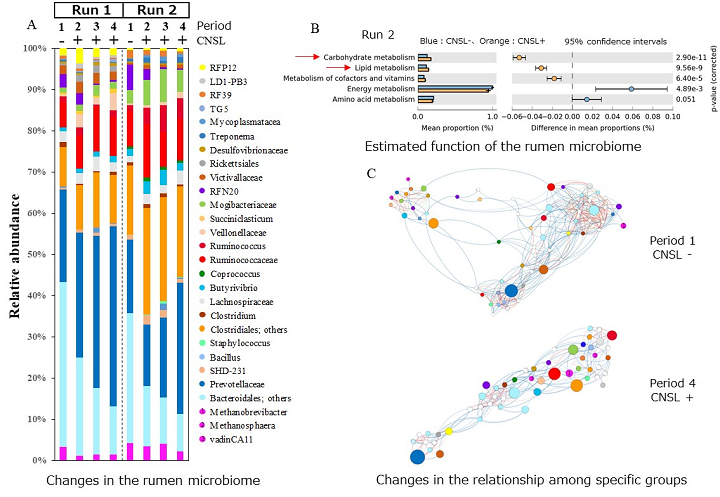Mitigation of methane emissions from Vietnamese local cattle (Lai Sind) by cashew nut shell liquid (CNSL) feeding
Description
Livestock production, especially ruminant production, is known to be one of the most significant sources of greenhouse gas (GHG) emissions in Southeast Asian countries. Therefore, there is an urgent need to develop technologies to mitigate GHG emissions from this sector in the region. A significant amount of cashew nuts is produced in Vietnam, leaving a significant amount of cashew shells as by-product. Cashew nut shell liquid (CNSL), extracted from the cashew shell, is known to contain antimicrobial compounds like anacardic acid, which can inhibit the activity of methanogens in the rumen of ruminants. Here, we evaluated the effect of CNSL feeding on methane emission from local cattle (named Lai Sind) in Vietnam. We also revealed the effect of CNSL on the activity of the microbiome in the rumen and its function, thus paving the way for the development of an effective CNSL feeding technology for GHG mitigation.Lai Sind cattle, the most widespread cattle breed in Vietnam, were used for the CNSL feeding experiment (n=4), with an average body weight of 246.1±22.6 kg for Run 1 and 375.0±36.0 kg for Run 2. The amounts of CNSL fed were 4 and 6 g/100 kg body weight per day for Runs 1 and 2, respectively.
Average methane emission per kg dry matter intake was reduced from 20.2% to 23.4% by CNSL feeding (Figs. 1A and 1B). Furthermore, CNSL feeding had a significant effect on the δ13C value of the methane produced, indicating that it significantly affected organic matter degradation in the rumen (Fig. 1C). CNSL feeding also affected the relative proportion of propionate in the short-chain fatty acid concentration in the rumen (Run 1: 8.2%→10.6%, p=0.001; Run 2: 17.7%→21.4%, p=0.015), while it did not affect feed degradation efficiency (data not shown). CNSL feeding significantly reduced the relative abundance of a major methanogen (order Methanobacteriales) while it significantly increased the relative abundance of family Prevotellaceae, which is known to degrade the polysaccharide or produce propionate (Fig. 2A). The estimated function of the rumen microbiome indicates that CNSL feeding significantly suppressed methane metabolism, which agrees with methane emission measurement, and that it enhanced carbohydrate metabolism or lipid metabolism at the same time (Fig. 2B). The results of 16SrRNA gene amplicon sequencing suggest that CNSL significantly reduced the diversity of the rumen microbiome, and the results of network analysis further indicate that a major methanogen (order Methanobacteriales) changed the functional partner in the rumen with the significant metabolic relationship (Fig. 2C).
Figure, table
-
Fig. 1. Enteric CH4 (black) and CO2 (grey) emissions per kg dry matter intake (DMI) from Lai Sind cattle, with (periods 2–4) and without (period 1) CNSL feeding (n = 4)
Error bars: standard deviation (SD). Different letters indicate significant differences (p < 0.05). Different doses of CNSL were set in Run 1 (4 g/100 kg BW: A) and Run 2 (6 g/100 kg BW: B). C. Changes in the δ13C values of enteric CH4 (Run 1). The δ13C values are expressed as relative to the VPDB (Vienna Pee Dee Belemnite). Each symbol (circle, triangle, square, and diamond) indicates individual cattle. Error bar: SD (n = 3)
-
Fig. 2. Effect of CNSL feeding on rumen microbiome
A. The effect of CNSL feeding on relative abundance of each group of the bacteria/archaea. B. Estimated function of the rumen microbiome and significantly changed features by CNSL feeding in Run 2. Orange and light blue at the bottom of the dendrogram indicate the results with (periods 2–4) and without (period 1) CNSL feeding. C. Output of network analysis for period 1 (without CNSL feeding) and period 4 (with CNSL feeding)
- Affiliation
-
Japan International Research Center for Agricultural Sciences Crop, Livestock and Environment Division
- Classification
-
Research
- Research project
- Program name
- Term of research
-
FY2020 (FY2011-FY2020)
- Responsible researcher
-
Maeda Koki ( Crop, Livestock and Environment Division )
Suzuki Tomoyuki ( Central Region Agricultural Research Center, NARO )
Nguyen Van Thu ( Can Tho University )
Le Van Phong ( Can Tho University )
Nguyen Minh Chon ( Can Tho University )
Yamada Keita ( Tokyo Institute of Technology )
Kudo Kushi ( Tokyo Institute of Technology )
Yoshida Naohiro ( Tokyo Institute of Technology )
Hikita Chie ( Idemitsu Kosan, Co. Ltd. )
- ほか
- Publication, etc.
-
https://doi.org/10.1111/1751-7915.13702
Maeda K. et al. (2020) Microb. Biotechnol.,
- Japanese PDF
-
2020_A01_A4_ja.pdf782.52 KB
2020_A01_A3_ja.pdf764.29 KB
- English PDF
-
2020_A01_A4_en.pdf463.34 KB
2020_A01_A3_en.pdf438.85 KB
- Poster PDF
-
2020_A01_poster.pdf701.99 KB
* Affiliation at the time of implementation of the study.


